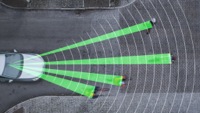Difference between revisions of "Detection"
(Created page with 'File:lighterstill.jpgright|frame *[http://en.wikipedia.org/wiki/15th_century 15th Century] ==Definitions== *1: th...') |
m (Text replacement - "http://" to "https://") |
||
| Line 1: | Line 1: | ||
[[File:lighterstill.jpg]][[File:Volvos-pedestrian-and-cyclist-detection-system.jpg|right|frame]] | [[File:lighterstill.jpg]][[File:Volvos-pedestrian-and-cyclist-detection-system.jpg|right|frame]] | ||
| − | *[ | + | *[https://en.wikipedia.org/wiki/15th_century 15th Century] |
==Definitions== | ==Definitions== | ||
*1: the act of detecting : the state or fact of being detected | *1: the act of detecting : the state or fact of being detected | ||
| Line 11: | Line 11: | ||
In general, '''detection''' is the extraction of particular [[information]] from a larger stream of information without specific [[cooperation]] from or [[synchronization]] with the sender. | In general, '''detection''' is the extraction of particular [[information]] from a larger stream of information without specific [[cooperation]] from or [[synchronization]] with the sender. | ||
| − | In the [[history]] of [[radio]] communications, the term "[ | + | In the [[history]] of [[radio]] communications, the term "[https://en.wikipedia.org/wiki/Detector_(radio) detector]" was first used for a device that detected the simple [[presence]] or absence of a radio [[signal]], since all communications were in [https://en.wikipedia.org/wiki/Morse_code Morse code]. The term is still in use today to describe a component that extracts a particular signal from all of the [[electromagnetic]] [[waves]] present. Detection is usually based on the [[frequency]] of the [https://en.wikipedia.org/wiki/Carrier_wave carrier wave], as in the familiar frequencies of radio broadcasting, but it may also involve filtering a faint signal from [[noise]], as in [https://en.wikipedia.org/wiki/Radio_astronomy radio astronomy], or reconstructing a hidden signal, as in [https://en.wikipedia.org/wiki/Steganography steganography]. |
| − | In [ | + | In [https://en.wikipedia.org/wiki/Optoelectronics optoelectronics], "detection" means converting a received optical input to a electrical output. For example, the light signal received through an [https://en.wikipedia.org/wiki/Optical_fiber optical fiber] is converted to an electrical signal in a detector such as a [https://en.wikipedia.org/wiki/Photodiode photodiode]. |
| − | In [ | + | In [https://en.wikipedia.org/wiki/Steganography steganography], attempts to detect hidden signals in suspected carrier material is referred to as [https://en.wikipedia.org/wiki/Steganalysis steganalysis]. Steganalysis has an interesting [[difference]] from most other types of ''detection'', in that it can often only determine the [[probability]] that a hidden message exists; this is in contrast to the detection of signals which are simply [https://en.wikipedia.org/wiki/Encryption encrypted], as the [https://en.wikipedia.org/wiki/Ciphertext ciphertext] can often be identified with [[certainty]], even if it cannot be decoded. |
| − | In the [[military]], detection refers to the special [[discipline]] of [ | + | In the [[military]], detection refers to the special [[discipline]] of [https://en.wikipedia.org/wiki/Reconnaissance reconnaissance] with the aim to recognize the presence of an object in a location or ambiance. |
| − | Finally, the ''art of detection'', also known as following [[clues]], is the work of a [ | + | Finally, the ''art of detection'', also known as following [[clues]], is the work of a [https://en.wikipedia.org/wiki/Detective detective] in attempting to reconstruct a [[sequence]] of [[events]] by identifying the relevant [[information]] in a situation. |
[[Category: Physics]] | [[Category: Physics]] | ||
Latest revision as of 23:45, 12 December 2020
Definitions
- 1: the act of detecting : the state or fact of being detected
- a. to discover the true character of
- b. to discover or determine the existence, presence, or fact of <detect alcohol in the blood>
- 2: to demodulate
- a. to extract the information from (a modulated signal)
Description
In general, detection is the extraction of particular information from a larger stream of information without specific cooperation from or synchronization with the sender.
In the history of radio communications, the term "detector" was first used for a device that detected the simple presence or absence of a radio signal, since all communications were in Morse code. The term is still in use today to describe a component that extracts a particular signal from all of the electromagnetic waves present. Detection is usually based on the frequency of the carrier wave, as in the familiar frequencies of radio broadcasting, but it may also involve filtering a faint signal from noise, as in radio astronomy, or reconstructing a hidden signal, as in steganography.
In optoelectronics, "detection" means converting a received optical input to a electrical output. For example, the light signal received through an optical fiber is converted to an electrical signal in a detector such as a photodiode.
In steganography, attempts to detect hidden signals in suspected carrier material is referred to as steganalysis. Steganalysis has an interesting difference from most other types of detection, in that it can often only determine the probability that a hidden message exists; this is in contrast to the detection of signals which are simply encrypted, as the ciphertext can often be identified with certainty, even if it cannot be decoded.
In the military, detection refers to the special discipline of reconnaissance with the aim to recognize the presence of an object in a location or ambiance.
Finally, the art of detection, also known as following clues, is the work of a detective in attempting to reconstruct a sequence of events by identifying the relevant information in a situation.
